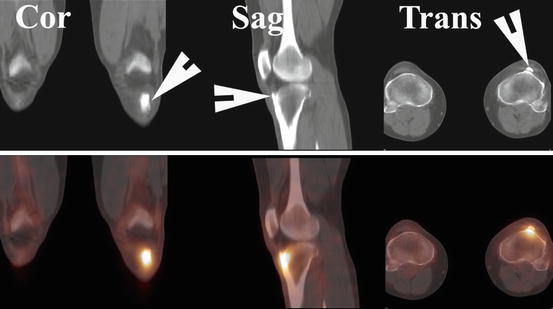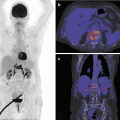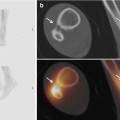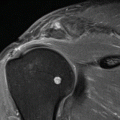Fig. 6.1
Acute fracture. Schematic representation of progression to fracture when the elastic limit of bone is exceeded. The bone may return to the resting state when the deformity is within the elastic limit
Fractures have a stereotypic response to injury. Repair occurs by laying down periosteal callus by apposition with formation of new bone in layers at a metaphyseal or diaphyseal level. There is remodelling in a synchronised manner, with osteoclasts removing dying osteons and osteoblasts producing new osteoid. Osteoid is mineralised by calcium phosphate with the development of hydroxyapatite.
Periosteal tissue responds within 48 h of injury, creating a splinting callus of trabecular and cartilaginous tissue. The soft-tissue response is characterised by angiogenesis and intense cellular activity. Calcification of the newly formed cartilage begins within days of the injury. Endosteal ossification occurs at a slower rate. Trabecular bone regains a mature laminar structure that after remodelling possesses the mechanical strength of the original tissue.
6.4.2 Chronic Injury
A dynamic balance between bone formation and resorption that is biochemically and biomechanically coupled was the basis of Wolff’s law. While this was first documented in 1892, it has been republished in 1986 (Wolff 1986). The biochemical and biomechanical understanding of this process has progressed markedly in the last 120 years. The current understanding is that osteocytes are the primary mechanosensors that regulate load-induced bony remodelling (Chen et al. 2009). Osteocytes live in an interstitial fluid milieu and are connected to each other by the canaliculi. If pressure gradients are applied to the bone, the hydrostatic pressure of the interstitial fluid changes and alters the flow in the canalicular systems, activating osteocytes (Chen et al. 2009). With chronic increase in bone stress, the microtrabecular architecture changes to accommodate the stress by laying down new bone parallel to the stress (Wolff’s law) (Frost 2004). This manifests as thickening of the medullary trabeculae and cortex (Chappard et al. 2008). However, thickened bone is less elastic and more prone to microcracks (Sahar et al. 2005), and persistent stress leads to osteocyte apoptosis (O’Brien et al. 2005). An imbalance in the osteocyte/osteoclast equilibrium leads to overactivity of the osteoclasts, making the preconditions for fracture more favourable (Fig. 6.2). When the stress exceeds the capability of the bone to respond appropriately, there is delamination of the cement lines in the cortical bone (Sahar et al. 2005) and eventual propagation of microcracks through the cortex with progression to frank fracture (Fig. 6.2).


Fig. 6.2
Chronic fracture. Schematic representation of the response of the bone to chronic stress with cortical thickening and progression to delamination of cement lines with microfractures and eventual cortical disruption
Significantly less trauma to osteoporotic or pathologically abnormal bone can lead to fracture at low levels of force. This is most common in the vertebral column and pelvis. Abnormalities of mineralisation will be reflected by prolonged uptake of the scintigraphic agents.
6.5 Epidemiology
Bone injury is the most important form of sporting and exercise-induced injury, particularly due to overuse. Studies indicate a significant delay in detection of stress fractures (Courtenay and Bowers 1990), unlike with acute fracture and soft-tissue injuries. Epidemiology of stress fractures has been the subject of a study by (Bennell and Brukner 1997) in which pooled data from a number of recent studies that met reasonable criteria for validity were included. Stress fractures accounted for up to 15.6 % of all injuries in an athletic population. Track and field accounted for 64 % of stress fractures in females and 50 % in males. In military recruits training over an 8-week period, the reported incidence rates varied from 1.1 to 13.9 % in women and 0.9 to 3.2 % in men. Six studies of athletic populations found that there was either no difference between females and males or a slightly increased risk for females (3.5 times the risk for males). The overall recurrence rates were quite high at 12.6 %. In those sustaining a fracture, 60 % gave a history of previous stress fracture. A retrospective study of 20,422 military recruits showed a positive association between increasing age and the incidence of stress fractures in both men and women (Brudvig et al. 1983).
If analysed by site, pooled data from18 studies (n = 2,254 cases) found 42 % of stress fractures in the tibia, 22 % in the metatarsals and 13 % in the fibula. The rest were distributed unevenly in the pelvis, navicular, femur, spine and upper limbs. Marked variation was shown between recreational and professional athletes. Of 368 fractures, stress fractures of the tibia were more common in professional athletes and stress fractures of the pelvis and metatarsals more common in recreational athletes (Hulkko and Orava 1987; Orava 1980). These studies also found that females sustained more metatarsal, pelvic and navicular fractures than males.
Approximately 9 % of fractures occur in children under 15 years of age, 32 % between 16 and 19 years and 59 % in patients over 20 years (Orava et al. 1981). Distribution of stress fractures in the paediatric population, extracted from pooled data, shows 51 % in the tibia, 20 % in the fibula, 15 % in the pars interarticularis, 3 % in the femur and 2 % in the metatarsals (Yngve 1988).
6.6 Scintigraphy: Technical Issues
Each scintigraphic study should be guided by the patient’s history and physical examination, regardless of the later use of SPECT/CT. Dynamic and blood pool studies are essential, particularly over the region of symptoms. Three-phase studies are important and will also increase the diagnostic yield for the complex regional pain syndrome (reflex sympathetic dystrophy) (Fig. 6.3). Positioning of the patient and the site of initial tracer injection are determined from a careful history (e.g. upper limb pathology is evaluated after intravenous injection in the foot). The face of the camera must be perpendicular to the growth plates in children to examine the metaphyseal regions carefully and look for asymmetry in the growth plates (Fig. 6.4). The blood pool is important in the decision regarding a diagnosis of fracture versus soft-tissue injury. It can provide incremental information on soft-tissue pathology involving the tendons, bursae, fasciae and synovial structures.
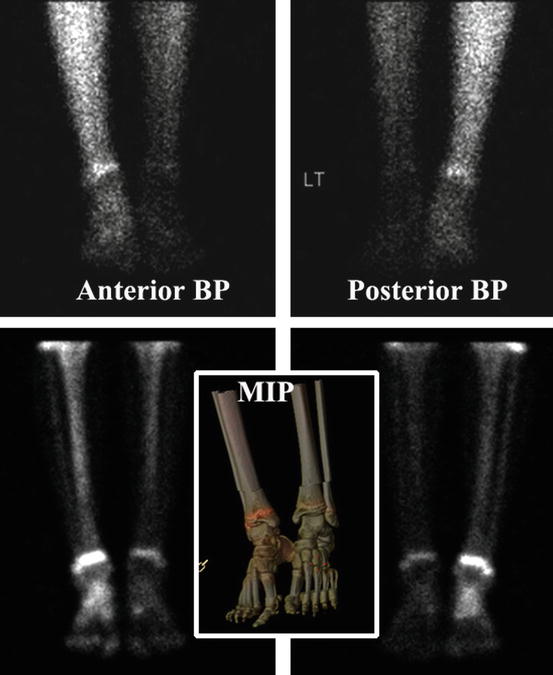
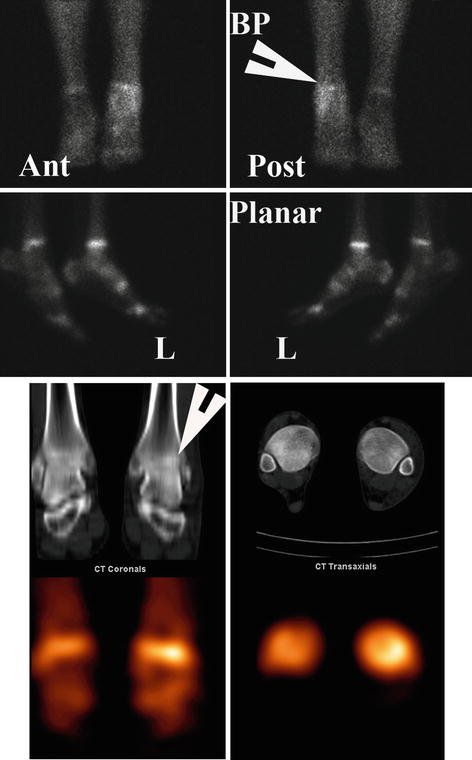

Fig. 6.3
Complex regional pain syndrome (reflex sympathetic dystrophy). Minor injury to the left foot led to burning pain and intermittent numbness in the left foot. Plain films were reported as normal. The scintigraphic study demonstrates globally reduced blood flow and delayed uptake in the left leg which is well illustrated in the MIP image. This is the “cold” variant of the syndrome. The more common manifestation is of diffuse increase in blood flow and delayed uptake, particularly in the periarticular areas

Fig. 6.4
Tibial growth plate injury. This 13-year-old male had a complex left ankle injury at football and could not weight-bear on the left leg due to ankle pain. Plain x-ray was reported as normal. The patient was scanned 3 weeks later. The blood pool image shows hyperaemia in the lateral aspect of the distal left tibia (arrowhead). The delayed and SPECT/CT studies reveal intense uptake in the lateral aspect of the left distal tibial growth plate with the CT study showing mixed lucency and sclerosis (arrowhead), compatible with a growth plate injury
6.7 Imaging Children
The most vulnerable part of the paediatric skeleton to trauma is the growth plate. The zone of provisional calcification is the most common site of trauma and has the potential for growth arrest if it extends into the germinal zones. Specific injuries can affect the apophysis, a growth plate that does not contribute to longitudinal growth. Salter-Harris staging system (I to V) is used in metaphyseal fractures with increased risk for longitudinal growth disturbance in type V (decreased width of the growth plate related to axial trauma). The most common sites involved are the distal radial and proximal humeral physis in the upper limb and the distal femoral and distal tibial physis in the lower limb. While injuries to the distal femoral physis account for only 2 % of all physeal injuries, they account for ~40 % of the causes of bony bridging (Peterson 1996). The most commonly affected apophyses are in the medial epicondyle (Little Leaguer’s elbow), olecranon, coracoid, acromion, vertebrae and around the pelvis. Radiographic evidence of damage includes widening of the growth plate and evidence of apophyseal separation. The scintigraphic equivalent is asymmetric increase in uptake in the affected growth plate (Fig. 6.4) (Connolly et al. 2001).
Great caution should be exercised in children with atypical symptoms as malignant tumours should be kept in mind and the practice of scanning the joint above and below the site of symptoms can yield surprising results.
6.8 Injury by Site
6.8.1 Soft-Tissue Injuries of the Ankle and Foot
The blood pool phase is crucial for detection of soft-tissue injuries. Hyperaemia in the affected structure may only show delayed uptake if there is a significant injury or close apposition to adjacent bony structures that react to the injury, as with the medial malleolus in tibialis posterior tendinopathy.
Such injuries affect the tendons, ligaments, joint capsule and bursae. Scintigraphy can demonstrate enthesopathy or traction injury of the Achilles tendon, the most commonly injured tendon (Fig. 6.5b). The tibialis posterior tendon is the second most frequently injured tendon, usually in ballet dancers and gymnasts. Tibialis posterior tendinopathy may also be seen in association with increased uptake in the accessory navicular bone, constituting the accessory navicular syndrome (Crisp 1998). A similar pattern of blood pool activity in the distribution of the tendon has also been described with the peroneal tendons (Fig. 6.6) (Sinha et al. 2000).
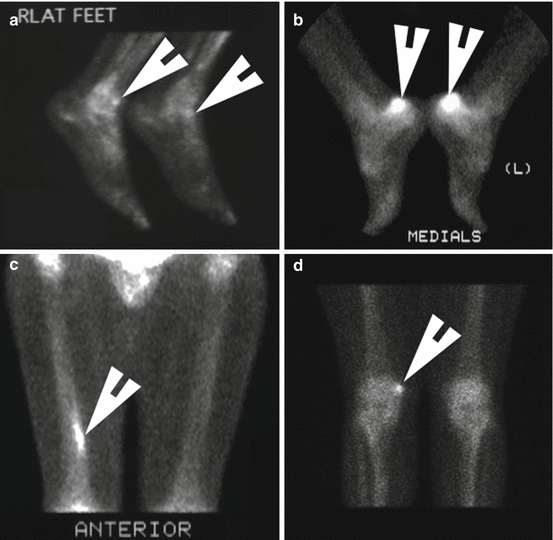
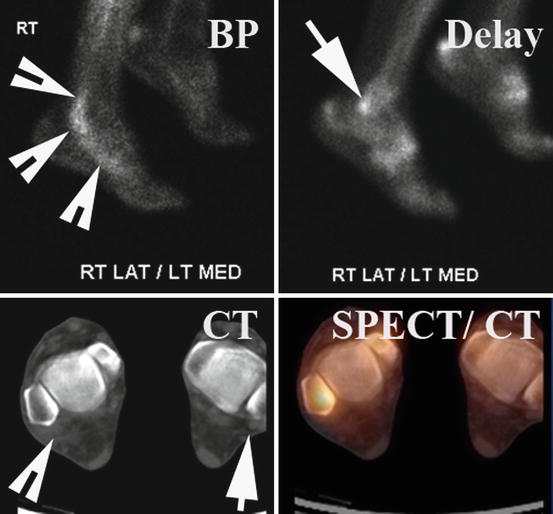

Fig. 6.5
Miscellaneous injuries of the lower limb. (a) Anterior impingement syndrome. Intense focal uptake in the anterior aspect of the ankles (arrowheads) due to repetitive traction on the anterior joint capsule and direct impingement of the anterior tibial plafond on the anterior talus. (b) Bilateral Achilles tendinopathy. Intense uptake around the Achilles tendons with associated bursitis (arrowheads). (c) Thigh splints due to overuse enthesopathy of the adductor muscles at the insertion into the distal femur (arrowhead). (d) Pellegrini-Stieda disease. Intense uptake at the medial collateral ligament insertion into the right medial condyle (arrowhead) after a ligament injury

Fig. 6.6
Peroneus brevis tendinitis. Intense hyperaemia is present along the distribution of the right peroneus brevis tendon in the blood pool image (arrowheads in BP). Intense uptake is present in the immediately adjacent posterior lateral malleolus (arrow in delay). The SPECT/CT image confirms these findings, and the CT study shows increased density and thickening of the tendon and its adnexae (arrowhead) compared with the unaffected side (arrow)
Posterolateral pain is usually due to posterior impingement syndrome, impingement of the os trigonum or peroneal tendinopathy. An os trigonum is present in approximately 3–13 % of the population. Posterior impingement may occur with forced plantar flexion of the ankle, as happens in ballet dancers. Posterior impingement can also be caused by an enlarged posterior talar process, prominent posterior calcaneal process, loose bodies or avulsion of the posterior tibiotalar ligament (Umans 2002). The scintigraphic appearance (Johnson et al. 1984) is characterised by intense uptake in the posterior talus.
The anterior impingement syndrome is caused by repeated traction of the anterior ankle joint capsule and impingement of the talus against the tibia. The chronic process leads to calcific deposits along the lines of the capsular fibres and spur formation on the dorsum of the anterior talus and tibia (Umans 2002). A pattern of intense increase in uptake of tracer is seen in the anterior aspect of the ankle (Fig. 6.5a).
6.8.1.1 Plantar Fasciopathy
Heel pain is one of the most common presentations in sports medicine, plantar fasciitis being the most common cause (Huang et al. 2000). Scintigraphy can offer information that can decide suitability for corticosteroid injection into the calcaneal enthesis (Frater et al. 2006). Other causes of heel pain that may be elucidated by scintigraphy include Achilles distal and insertional tendinopathy and bursitis (Fig. 6.5b), retrocalcaneal bursitis, apophysitis of the calcaneus and calcaneal stress fracture. SPECT/CT can accurately show the site of tendon attachment and its relationship to uptake. Incremental information in Achilles tendinopathy includes opacification of the Kager fat pad on CT.
6.8.2 Ankle and Foot: Bony and Ligamentous Injury
Multiple studies have evaluated the performance of SPECT/CT in the lower limbs over the last few years. The intraobserver/interobserver variability in 20 consecutive patients with foot pain and degenerative disease of various joints was found to be good (Pagenstert et al. 2009) with a kappa score of 0.86 (Cohen 1968). A good recent review of the technical and clinical applications of SPECT/CT in the foot and ankle in a variety of conditions is well illustrated in a recent publication by Mohan et al. (Mohan et al. 2010).
The ankle is the dominant focus of acute injury in up to 75 % of participants in sport (Yeung et al. 1994) with 15 % having serious sequelae (Fallat et al. 1998). Approximately 70 % of acute injuries are inversion “sprains” with injury to the lateral ligamentous complex of the ankle and less often on the medial side. A small proportion of patient will incur serious injuries to the talus (Fig. 6.7), tibio-fibular syndesmosis, cuboid, calcaneus (Figs. 6.8 and 6.9) or navicular bones.
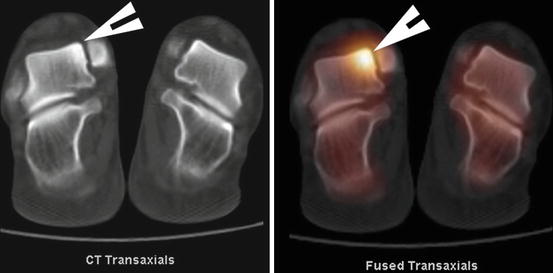
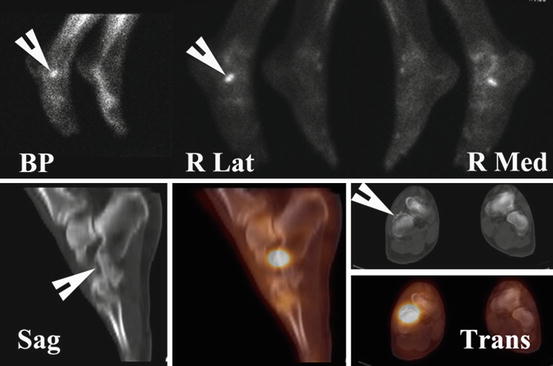
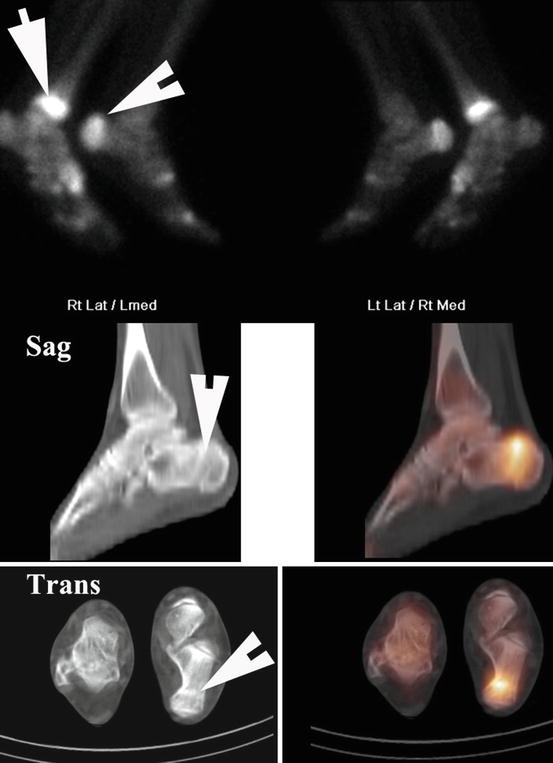

Fig. 6.7
Talar dome fracture. Intense uptake and sclerosis of the medial talar dome (arrowhead) in a patient who had an “ankle sprain” at soccer and could not weight-bear for several weeks

Fig. 6.8
Anterior calcaneal fracture. Footballer who had a complex rotational injury of the right foot and could not weight-bear. The blood pool study (BP) shows intense hyperaemia and uptake in a vertical distribution in the anterior aspect of the right calcaneum (arrowheads) in the upper panel. The SPECT/CT images in the lower panel confirm intense uptake in the anterior aspect of the right calcaneum with disruption of the cortex (arrowhead) at the site of fracture

Fig. 6.9
Posterior calcaneal fracture. This triathlete had previously developed a stress fracture of the right distal tibia (arrow in upper panel) and refused to stop training. He subsequently complained of pain in the left heel. Planar images showed vertical increase in uptake extending through the left posterior calcaneum (arrowhead in upper panel) with the SPECT/CT images showing both increased uptake and sclerosis (arrowheads in lower panels) compatible with a stress fracture
6.8.2.1 Talar Dome Fractures
Osteochondral fractures complicate acute ankle sprains in up to 6 %, most commonly in the posteromedial talar dome followed by the anterolateral talar dome (Shea and Manoli 1993); these lesions are generally known as osteochondral lesion of the talus (OLT). Plain x-ray may miss up to 33 % of fractures (Stroud and Marks 2000). Plain radiography has an accuracy of 25 % when correlated with arthroscopy (Stroud and Marks 2000). Scintigraphy is a good screening test in the presence of a normal radiograph, as was shown in a small series of 24 patients (Anderson et al. 1989). In a larger series of 122 patients, bone scintigraphy was shown to have a sensitivity of 94 % and specificity of 76 % for detecting talar dome fractures (Urman et al. 1991). Blood pool abnormalities were associated with higher grade and unstable fractures. The obvious additional advantage of SPECT/CT is that it can provide a more accurate site of uptake in the talus and stage the fracture in terms of instability of the fracture fragment. There are no available series to provide a critical assessment of performance of the technique, particularly against MRI.
6.8.2.2 Acute Fractures of the Plafond and Interosseous Membrane
A study of 639 cases of ankle sprains found that 15 % had either avulsion or compression fractures and 5 % had significant injuries to the interosseous membrane (Fallat et al. 1998). These lesions are related to a more uncommon type of ankle injury with eversion. Bone scintigraphy shows hyperaemia in the posterior aspect of the ankle, extending superiorly into the interosseous membrane. Delayed images demonstrate increased uptake in the posterior plafond (avulsion or chip fracture) and medial edge of the posterior fibula (avulsion fracture) and extension into the distal syndesmosis (Frater et al. 2002). This injury is often associated with a fracture of the proximal fibula (Maisonneuve fracture). In theory, SPECT/CT should increase the accuracy with which such fractures are detected and allow staging of the fracture stability and the need for surgical intervention.
6.8.2.3 Fractures of the Tarsal Bones
Stress fracture of the talus is rare. Although rare in overall terms, acute navicular fractures are the most common mid-foot fracture and require careful treatment in order to avoid long-term morbidity. The dorsal ligament avulsion fracture is the most common navicular fracture and presents with pinpoint tenderness after eversion or inversion injury on a plantar-flexed foot. Navicular stress fractures are being seen with increasing frequency due to the increasing participation of women and adolescents in various sports. Fractures are easily detected by scintigraphy, CT and MRI in nearly all cases (Orava et al. 1991; Boden and Osbahr 2000). Fracture of the accessory navicular bone may be seen in association with tibialis posterior tendinopathy in the accessory navicular syndrome (Conti 1994). The accessory navicular bone may be bilateral, and injury is easily diagnosed by scintigraphy by comparing the sides (Fig. 6.10).
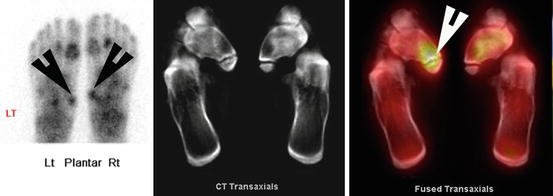

Fig. 6.10
Accessory navicular fracture. This older weightlifter dropped a weight on the dorsum of the right foot and complained of increasing pain in the foot. Plain films reported an incidental accessory navicular but could not detect a fracture. The planar image shows increased uptake of tracer in both accessory navicular bones (arrowheads) which is more marked on the right side. However, the SPECT/CT images clearly identify more intense uptake and irregular sclerosis around the articulation, in keeping with a fracture through the syndesmosis
Cuboid fractures are unusual and account for approximately 5 % of all tarsal fractures (Lee and Donatto 1999). Cuneiform fractures comprise approximately 4 % of all mid-foot fractures (Fig. 6.11) (Lee and Donatto 1999). Acute fractures of the anterior process of the calcaneus have been reported to account for up to 15 % of all calcaneal fractures (Fig. 6.8) (Hodge 1999). The Lisfranc injury should always be considered in cases where there is an inability to weight-bear associated with mild swelling of the mid-foot and bruising of the arch of the foot. Weight-bearing plain films of the foot are generally diagnostic, but scintigraphy may prove to be useful in approximately 15 % of cases with more subtle injury to the joint that is not apparent on plain film.
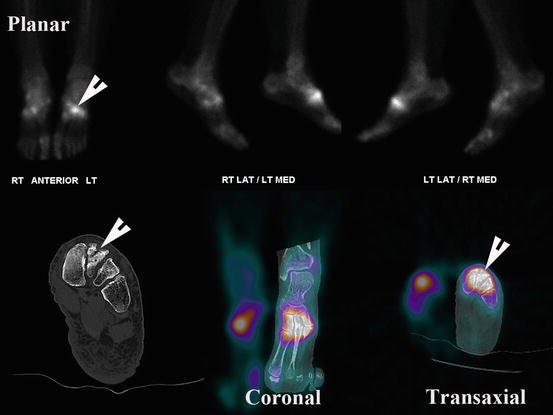

Fig. 6.11
Cuneiform stress fracture. Long-distance runner who presented with increasing pain in the left mid-foot region. Plain films 3 weeks previously had been reported as normal. Intense uptake is seen in the left intermediate cuneiform bone (arrowheads). SPECT/CT confirms this, with the CT study clearly demonstrating the fracture site (arrowhead). Note multiple other sites of increased uptake which were asymptomatic, as is commonly found in high-level athletes
Stress fractures of the calcaneus have been reported in approximately 20 % of male and 40 % of female military recruits undergoing basic military training (Greaney et al. 1983; Pester and Smith 1992). The most common site of fracture is the posterior calcaneal tubercle (Fig. 6.9).
SPECT/CT should increase the accuracy with which such fractures are detected and allow staging of the fracture stability and the need for surgical intervention.
6.8.2.4 Metatarsal Stress Fracture
Metatarsal fractures are the most common stress injury in the foot and ankle. In a large series of 295 subjects with 339 stress fractures, 28 % were in the metatarsals (Brudvig et al. 1983). These injuries occur in athletes who participate in high-impact sports involving mainly running and jumping. Stress fractures predominantly (90 %) occur in the second (Fig. 6.12) and third metatarsal bones. There is also a high level of stress through the fifth metatarsal, although less than in the second (Donahue and Sharkey 1999). Fractures of the fifth metatarsal are usually through the shaft and more rarely, proximally located (Jones fracture) (Hulkko et al. 1985). Synovitis of the metatarsophalangeal (MTP) joints should not be confused with stress fracture, particularly when the second MTP joint is involved (Smith and Reischl 1988; Thompson and Hamilton 1987). The condition is more common than was previously recognised, and awareness is important in order to avoid misdiagnosis (Smith and Reischl 1988).
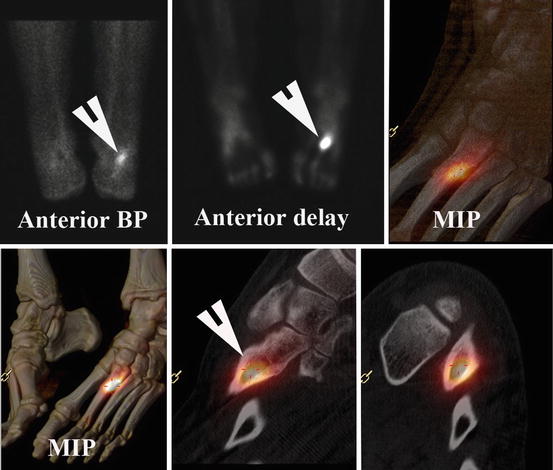

Fig. 6.12
Metatarsal stress fracture. Runner presenting with pain in the left foot which worsened after tripping. Tenderness of the left second metatarsal bone in left foot. The blood pool image (BP) shows intense hyperaemia in the base of the left second metatarsal. The delayed study confirms intense uptake in this metatarsal (arrowhead in anterior delay). This is confirmed in the MIP images and the SPECT/CT fused study which shows intense uptake with cortical thickening and sclerosis of the base of the left second metatarsal (arrowhead)
6.8.2.5 Sesamoid Injuries
The sesamoid bones beneath the first metatarsal head are within the capsule of the first metatarsophalangeal (MTP) joint and may be multipartite in 5–30 % of people. Stress fractures may therefore be difficult to diagnose radiologically. Scintigraphy has been found to be useful in the diagnosis of injury to the sesamoids in case studies (Georgoulias et al. 2001).
6.8.2.6 Tarsal Coalition
Failure of segmentation of the mesenchymal tissue of the hindfoot bones in the embryo is thought to be the cause of tarsal coalition. An autosomal dominant inheritance pattern has been established, and tarsal coalitions occur in approximately 1 % of the population. Fifty percent will be bilateral and a significant proportion has multiple coalitions (Bohne 2001). Coalitions of the talo-calcaneal (Fig. 6.13) and calcaneo-navicular bones are the most common, followed by the talo-navicular and calcaneo-cuboid bones. These coalitions may be fibrous, cartilaginous or bony. Symptoms usually occur when the coalitions ossify and present with pain in the early to middle teens with ankle pain in the lateral and anterolateral aspects of the ankle. Physical examination shows a valgus hindfoot and patients may have a flatfoot. The flatfoot is usually associated with peroneal muscle spasm due to hindfoot rigidity. Mandell et al. (1990) reported the successful localisation of 7/9 fibrous talo-calcaneal coalitions using pinhole scintigraphy.
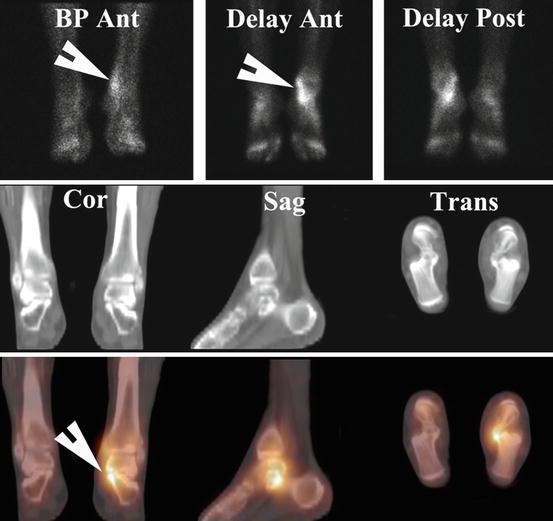

Fig. 6.13
Talo-calcaneal coalition. Runner who had a minor injury to the left ankle and complained of disproportionate pain. Plain films were reported as normal. The planar images in the upper panel demonstrate intense hyperaemia in the left medial ankle in the blood pool image (arrowhead). Delayed images also show intense uptake in the medial aspect of the left ankle which could plausibly be due to a ligament injury. However, SPECT/CT images confirm uptake around the medial facet of the articulation between the talus and navicular (arrowhead), and the CT image clearly demonstrates the coalition
SPECT/CT offers a window into a complex anatomical region and would allow the early detection of uptake at the site of coalition and allow the detection of complicating osteoarthritis as well as occult coalitions (Mohan et al. 2010).
6.9 Tibia and Calf
Stress fractures of the tibia are the single most common fracture in sports medicine (McBryde 1975, 1985; Devas 1975). The diagnosis must be distinguished from the medial tibial stress syndrome (shin splints) and compartment syndrome. Stress fractures of the fibula are less common but may occur in association with other injuries.
6.9.1 Tibia and Calf: Soft-Tissue Injury
The two major chronic soft-tissue injuries are shin splints (medial tibial stress syndrome) and the chronic compartment syndromes. Other causes of pain include entrapment of arteries and nerves, deep venous thrombosis, rupture of the gastrocnemius muscle, fascial herniations and muscle strains. Muscle strains are probably the single most common cause of acute pain in the lower limbs (Kortebein et al. 2000).
6.9.1.1 Shin Splints (Medial Tibial Stress Syndrome)
Shin splints have been called the medial tibial stress syndrome due to the localisation of exercise-induced pain to the posteromedial aspect of the distal two thirds of the tibia (Kortebein et al. 2000). Considerable controversy surrounds the aetiology of so-called shin splints. Biopsy evidence shows inflammation of the crural fascia and increased bony metabolism with vascular ingrowth in the majority (Kortebein et al. 2000). The triple-phase bone scan appearance was well described by Holder and Michael (1984) as showing low-grade uptake in the distal posteromedial tibia on the delayed phase only (Fig. 6.14), with no alterations in blood flow. Scintigraphic studies currently define the diagnosis.
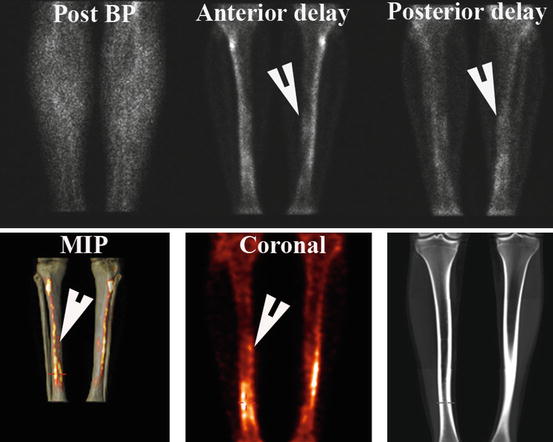

Fig. 6.14
Medial tibial stress syndrome (shin splints). Typical appearance of long segment low-grade uptake in the posteromedial cortex of the tibia (arrowheads) with normal blood pool image. The SPECT/CT image confirms irregular cortical uptake in the posteromedial surface of the tibiae, which is also well shown in the MIP image (arrowheads)
6.9.2 Tibia and Calf: Bone Injury
6.9.2.1 Tibial Stress Fractures
A variable incidence of tibial stress fractures has been reported, reflecting the heterogeneity of the study populations. While incidence does vary from 4 to 31 %, it accounts for over 50 % of all stress fractures, particularly in military recruits (Devas 1975; McBryde 1985). Predisposing factors include altered biomechanics in the lower limb, changes in footwear or rapid acceleration in the level of activity.
The utility of bone scintigraphy in the early diagnosis of tibial stress fractures has been well established since the description of early detection compared to plain radiology in the mid-1970s (Geslien et al. 1976). The usual scan appearance is of hyperaemia with intense transverse uptake at the site of fracture. More recent literature has shown an equivalence with MRI for early diagnosis (Brukner and Bennell 1997; Ishibashi et al. 2002) with scan findings of periosteal and bone-marrow oedema. The posterior aspect of the upper third of the shaft is the most common site of fracture in children and the elderly. The distal third is the most common site in long-distance runners (Fig. 6.15).
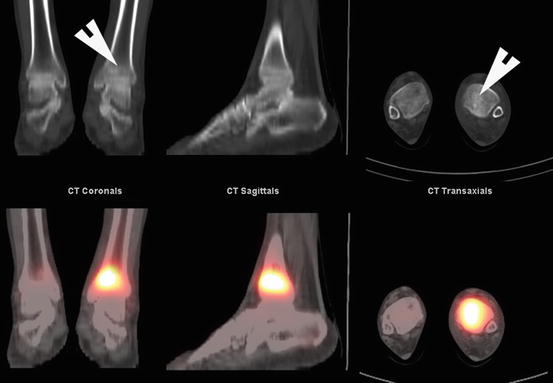

Fig. 6.15
Tibial stress fracture. Typical tibial stress fracture in a long-distance runner who progressively developed pain in the left ankle with increasing activity to the point where she was unable to run. The SPECT/CT study shows intense uptake in the distal left tibia with a sclerotic band in the CT study (arrowheads) at the site of fracture
In a large series (Zwas et al. 1987), 164 of 280 fractures occurred in the mid-shaft. This group described a classification of tibial stress fractures into four grades, extending from poorly defined cortical uptake (Grade I) to well-defined intramedullary transcortical uptake (Grade IV). The scintigraphic grade of uptake gave valuable prognostic information regarding the period of rest required for healing, being more prolonged in the higher grades. Plain radiography can also indicate poor prognosis with the dreaded black line, indicating osteolysis at the fracture site, a poor prognostic indicator for healing with high likelihood for surgical intervention (Miyamoto et al. 2009).
SPECT has been shown to be a sensitive method of detecting early tibial stress fractures, especially in high-level athletes with minimal symptoms (Yildirim et al. 2004). This study found abnormal uptake in 28 of 42 high-level soccer players, 62 % being in the tibia. Although there are no critical studies of SPECT/CT, CT would add to the staging information and allow better treatment planning.
6.9.2.2 Fibula Stress Fractures
Stress fractures of the fibula account for 20 % of paediatric (Yngve 1988) and up to 30 % of adult stress fractures (Bennell and Brukner 1997). The vast majority develop in the distal third (Fig. 6.16), with the proximal and middle third being rare. Scintigraphy has been established as a reference standard since the earliest experiences with athletic injuries (Geslien et al. 1976).
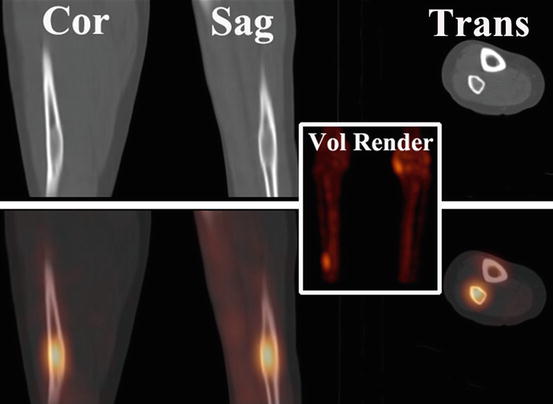

Fig. 6.16
Fibula stress fracture. Triathlete who complained of increasingly disabling pain in the right leg. The SPECT/CT study clearly shows intense uptake and sclerosis in the distal third of the right fibula at the site of stress fracture. This is well illustrated in the volume-rendered image in the central panel
6.9.3 Knee Injury
The knee is susceptible to injury in any activity that involves rapid changes in direction. The menisci separate the femoral condyles from the tibial plateau. The cruciate ligaments, medial and lateral collateral ligaments, joint capsule and muscles afford joint stability. Planar imaging can yield a number of diagnoses such as bursitis, enthesopathy, osteochondritis dissecans, bone bruises or fractures of the tibial plateau. Internal derangements of the knee may be detected by SPECT images but are a subject of redundancy, given the far better capability of MRI in detecting and surgically staging most injuries. While there is potential for SPECT/CT to improve the accuracy of diagnosis and staging of knee injuries, it is likely to remain an orphan imaging modality or research tool, as MRI is unlikely to be abandoned.
6.9.3.1 Acute and Chronic Injury
Knee SPECT has a defined role in the assessment of both acute and chronic knee pain (al-Janabi 1994; Ryan et al. 1996; So et al. 2000; Ryan et al. 1998; Murray et al. 1990). Good to excellent performance has been shown (Ryan et al. 1996) in a variety of knee disorders in 158 patients in which knee SPECT made the correct diagnosis in 89 %. Even if SPECT does not provide a specific diagnosis, it may be helpful in directing arthroscopy and shortening the examination (Ryan et al. 1996; Murray et al. 1990). A recent series of three case reports indicates the potential utility of SPECT/CT in the post-operative knee that is painful (Hirschmann et al. 2010).
6.9.3.2 Meniscal Injury
Knee SPECT has been evaluated in the setting of chronic and acute meniscal tears (Collier et al. 1985; al-Janabi 1994; Ryan et al. 1996, 1998, 2000; Murray et al. 1990). Meniscal tears are characterised by peripherally increased uptake in a crescent in the tibial plateau (Fig. 6.17) as well as focal posterior femoral condylar uptake (Ryan et al. 1998, 2000; Murray et al. 1990). Ryan et al. (1998) in a study of 100 patients with undiagnosed knee pain showed a sensitivity of 84 %, specificity of 80 %, positive predictive value of 88 % and negative predictive value of 76 % for SPECT, with similar values for MRI. However, recently published prospective MRI studies (Van Dyck et al. 2013) show a much higher accuracy for the detection of meniscal tears of 92–95 % with sensitivity 93 % and specificity 90 % for medial meniscal tears. Sensitivity was 82 % and specificity 98 % for lateral meniscal tears.

